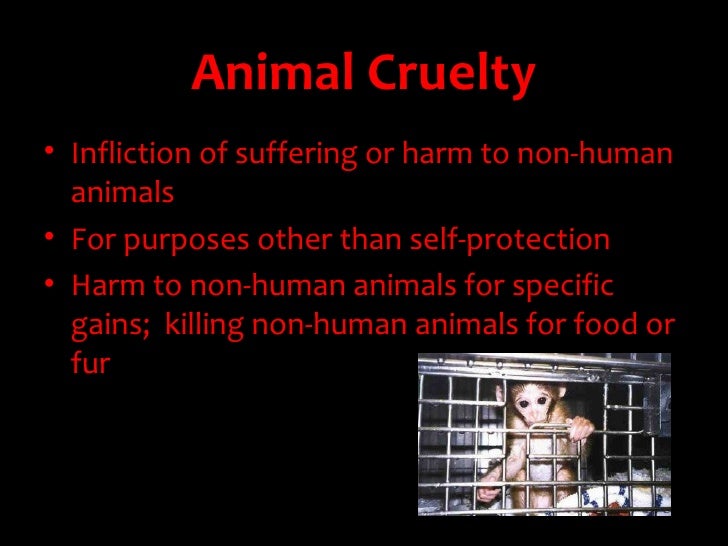In contemporary society, animal cruelty elicits intense debates, particularly when differentiating between moral and legal viewpoints. This dichotomy shapes the discourse surrounding animal rights and welfare, compelling us to question the ethics underpinning our treatment of animals. Understanding this complex interplay necessitates a nuanced examination of both moral philosophy and legal frameworks.
One cannot ignore that moral objections to animal cruelty often stem from deeply held ethical beliefs. At the heart of many moral arguments is the concept of sentience—the capacity to experience feelings such as pain, joy, and suffering. Many philosophers, including Peter Singer and Tom Regan, argue that sentience obligates humans to extend moral consideration to non-human animals. The moral standpoint posits that because animals can suffer, they have an inherent right to live free from harm and exploitation.
This moral perspective is further enhanced by the philosophical underpinnings of utilitarianism, which advocates for actions that maximize happiness and reduce suffering. Under this line of reasoning, inflicting pain on animals for trivial human pleasures, such as entertainment or taste preferences, is morally indefensible. The implications of this viewpoint extend beyond simply refraining from direct harm; it calls for significant lifestyle changes, such as adopting plant-based diets or refraining from patronizing businesses that exploit animals.
Conversely, the legal standpoint on animal cruelty revolves around the codification of laws designed to protect animals from harm, establishing a formally recognized framework that dictates acceptable behavior. In many jurisdictions, animal cruelty is defined and prohibited through specific statutes. These laws typically classify acts of cruelty into categories, such as neglect, abandonment, and intentional harm. While legal definitions vary globally, the underlying principle remains: protecting animals from unnecessary suffering.
Despite the existence of these laws, the efficacy of legal frameworks is often scrutinized. In numerous cases, laws are poorly enforced, leading to inadequate protection for animals. Sentiments surrounding animal rights can sometimes clash with cultural norms, allowing for practices that are historically significant or economically beneficial to persist, even in the face of ethical concerns. For instance, some regions continue to endorse practices like bullfighting or seal hunting, revealing the deep cultural embeddedness of certain forms of animal exploitation.
This intersection of morality and legality presents a conundrum; laws may not always align with evolving ethical standards. The legal system is reactive by nature, often lagging behind societal shifts in moral consciousness. A prominent example is the increasing recognition of animal sentience in various legal systems. Though traditionally regarded as property, many jurisdictions are beginning to acknowledge animals as living beings deserving of rights. This paradigm shift necessitates a reevaluation of existing legal frameworks, which may not adequately protect animals in light of contemporary ethical critiques.
Moreover, the globalization of information has catalyzed a growing awareness of animal welfare issues. The rise of social media and advocacy campaigns has prompted a collective moral awakening, urging individuals to scrutinize their own behaviors and the systems that perpetuate cruelty. Grassroots movements and organizations now play a pivotal role in reshaping the legal landscape, pressuring lawmakers to enact more stringent protections for animals. Community outreach programs often highlight the plight of abused and neglected animals, bridging the gap between moral advocacy and legal reform.
Interestingly, the convergence of moral and legal perspectives can lead to groundbreaking advancements in animal rights. Landmark cases, where courts have ruled in favor of animals, underscore the potential for legal systems to reflect moral progress. Such decisions often resonate beyond the courtroom, galvanizing public support and setting precedents for future legislation. The recent legal recognition of certain animal species as sentient in countries like Switzerland and New Zealand illustrates this transformative potential.
However, it would be remiss to assume that the path toward comprehensive animal rights is linear. Significant challenges remain. Legal loopholes, lack of funding for enforcement, and societal resistance can hinder progress. Additionally, the ingrained attitudes toward animals fostered by centuries of cultural practices create obstacles to acceptance of new moral frameworks. For true change to occur, both moral and legal advocates must collaborate to create comprehensive educational initiatives that foster empathy and compassion towards animals.
In conclusion, the dialogue surrounding animal cruelty as a moral versus legal issue is multifaceted and ongoing. While legal frameworks provide a crucial foundation for protecting animals, they must be informed by evolving moral perspectives to ensure effective advocacy. The relationship between laws and ethics remains dynamic, each influencing and shaping the other in a perpetual cycle of growth and development. It is incumbent upon individuals, activists, and lawmakers alike to cultivate a culture that recognizes and respects the intrinsic value of all sentient beings, ultimately cultivating a society that champions kindness over cruelty. Only through this collective moral awakening can we hope to eradicate the blight of animal cruelty and foster a world where compassion reigns supreme.








